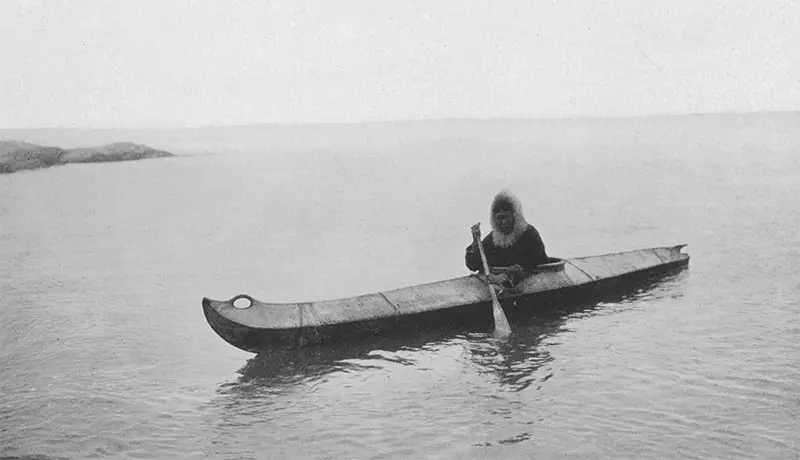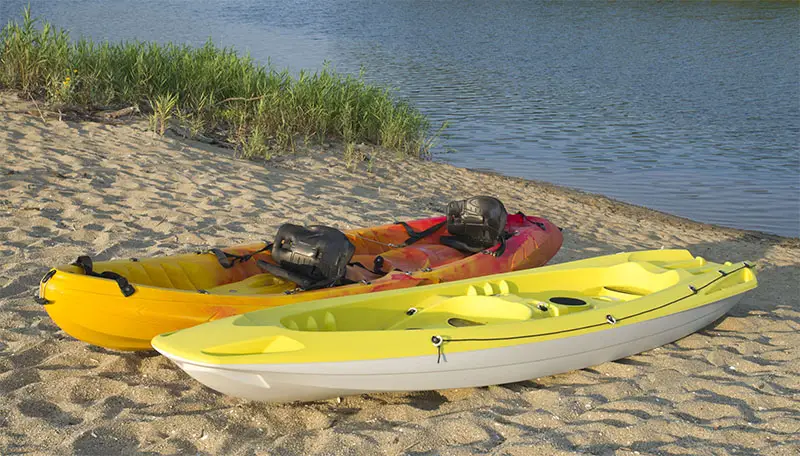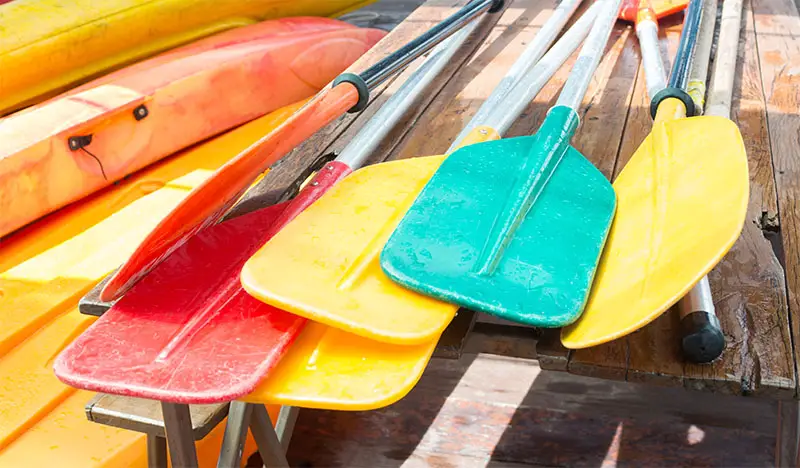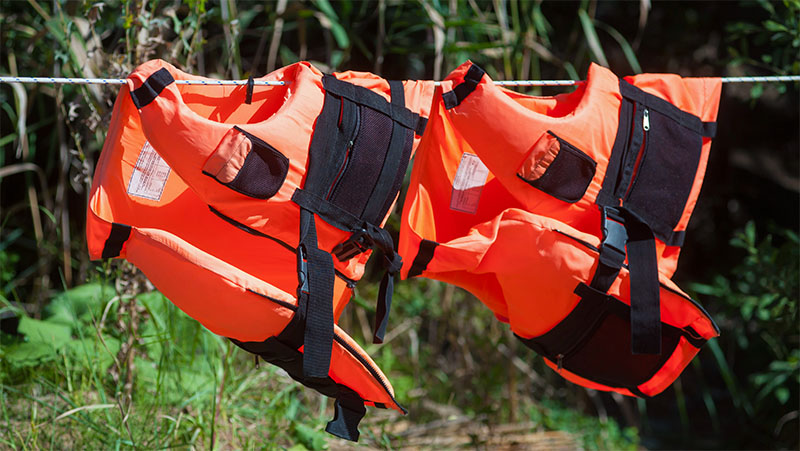Contents
Is Kayaking Hard?
In the past decade, kayaking has exploded in popularity. In 2015, it was reported that there were over 21 million Americans actively taking part in some form of paddling for leisure—paddle boarding, canoeing, and kayaking. With kayaking being one of the most common types, you can clearly see that it is a popular activity!
Kayaking is popular for a lot of reasons. It’s one of the most affordable ways to get out on the water. The differing types of kayaks offer opportunities to explore different types of water. It’s accessible to many people, and the number of people who go kayaking shows it is popular.
If you’ve been thinking about venturing into the world of kayaking, you may wonder if you can do it. Is kayaking hard? Is it strenuous? Is it dangerous? There are lots of questions that may run through your head, and we’re going to answer all of those today with our top 4 things you need to know to be ready to kayak!
All About Kayaks

Before we get into the specifics about kayaking, let’s take a trip back to where it all began! Kayaks actually have a modest beginning, but, as stated above, have since exploded into a world-wide phenomenon.
History
We believe kayaks to be around 4,000 years old. Originally, native people of the arctic regions of North America used kayaks. Their intended purpose was to be a small, sleek boat that would allow hunters to sneak up on their prey without being seen or heard.
They not only used kayaks differently back then, but they looked very different as well! During those ancient times, the arctic natives made kayaks out of animal skin and whale bones!
Uses
We’ve come a long way in both design and use with kayaks. Because of the different types of kayaks available, people can use them in all different climates for a variety of reasons. While, of course, people can use kayaks for leisure and exercise, some also use them for fishing, competitions, whitewater running, touring, camping, rescues during floods, and much more.
Benefits
While we’re exploring whether kayaking is hard, we’ve got to make sure we look at the benefits it can bring. First, no matter how you are using it from the list above, kayaking is excellent exercise. It works your upper body, while also tightening your core. It also serves as a great way to cross train from your regular workouts.
Apart from the fitness perspective, kayaking can be really calming and peaceful. Even if you’re using it for whitewater kayaking, there’s a level of heightened focus that can bring your attention to the present, relieving you of any stresses you may be dealing with.
1. Picking The Right Kayak

When you are thinking about incorporating kayaking into your fitness routine or lifestyle, you’ll need to start by thinking about what type of kayak you’ll need. To do this, when thinking about the questions below, you need to have a location in mind. You can kayak in rivers, on lakes, in the Ocean and more. This can affect the type of kayak that you will be using.
What Size Kayak Do I Need?
We typically use longer kayaks in calmer waters and for longer distances travelled because of the added storage space. Short kayaks are more recreational, like whitewater kayaking. So, when you’re thinking about the size of your kayak, you need to consider what you’ll typically be using it for and what the water conditions will more than likely be like.
Another consideration for the size of your kayak is whether you want it to be a one person or two person, or tandem, kayak. Again, since a two person kayak is longer, most people use them more for leisure.
Which Kayak Is Most Stable?
According to Paddle Camp, there are actually two types of stability that kayakers should consider before investing in their own. There’s primary stability and secondary stability. So, in picking a kayak that is the “most stable”, it will depend on what you’re looking for.
Primary stability refers to the amount of stability you feel with small variances and leaning. Kayak primary stability is ideal for beginners who plan on being in calmer waters because they designed it to keep you upright in these situations. But, when you reach a certain point, or lean too far, it will capsize and flip.
Secondary stability refers to stability when the going gets tough. When the waters are rough, you want a kayak with secondary stability. It’s how well your kayak handles your variances and leaning into sharp turns and big movements without capsizing.
Unfortunately, you can’t find a kayak for both. They’re shape, length, and volume are specifically designed for either calmer waters or more turbulent ones. So, again, when you’re deciding, you’ve got to consider what you’re using it for, and there will be a stable kayak specifically designed for you!
Sit On Top Kayaks
Once you decide on the size and stability you desire, you’ll look at whether you prefer a sit-on-top, sit-inside kayak, or even an inflatable one! They each have their own pros and cons depending on what you’re looking for!
Sit on top kayaks like the name suggests, is where the seat is on top of the kayak out of the water. There are many pros to selecting a kayak where you sit on the top. It is very easy to get on and off of and is ideal for areas where the water is warm and you enjoy getting in the water. The downside to this is that it may also be easier to fall in. However, like I said, if that’s something you’re looking for and you want a kayak that is easy to get back in without feeling restricted, this is the type for you!
Sit In Kayaks
Also known as whitewater kayaks, they design sit-inside kayaks for rougher and even colder waters. As the name (sit-inside) suggests, the person using it is sitting inside the kayak area known as the cockpit.
Unlike the sit-on kayaks where you’re more than likely going to get wet, they design sit-insides for you to stay dry. And, while they are more stable in keeping you inside, they can be more challenging to get back into if you capsize. That’s definitely something to think about!
Inflatable Kayaks
They make most kayaks these days out of durable plastic, but there are others out there on the market in a variety of price ranges. They make more expensive versions out of fiberglass or Kevlar, but more and more people are selecting inflatable kayaks as a cheaper alternative.
Not only is it a pro that they are more affordable, they are also a lot easier to store. Because it’s inflatable, you can deflate it and easily store, whereas the other kinds would require a lot more space. While they are more versatile than you may think, they aren’t as fast or as versatile as one made from hard plastic.
2. Picking Kayak Paddles

Once you’ve picked your kayak, you’ve got to pick the right paddles. If you’re new to kayaking, you may not have even realized that there were different paddles at all. That’s why we’ve included it in our list of the 4 things you need to know!
So, which paddle for kayaking? Well, kayak paddles are distinct from canoe paddles in a couple of different ways. Because canoes are typically heavier and longer, it requires two people to paddle where a kayak only requires one. Because of this, a kayak paddle has blades on each end to allow you to control it all yourself, crossing from one side of the kayak to the other.
When you’re picking your paddle, you’ll more than likely need to consider two things: the type of blade and whether it has a curve.
Blades for kayaks either come symmetrical or asymmetrical. While most beginners will not even notice a difference with a side-by-side comparison using them in the water, it’s important to note the difference. If you are exploring more intense waters like the Ocean or white water paddling, the asymmetrical blades will provide you with more control whereas symmetrical blades are more forgiving and better for calmer waters.
Another thing to note when selecting your paddle is the curve. Some paddles are flat while others are not. Curved blades, like the asymmetrical shapes, are for rougher waters and for the more trained kayaker. Flat blades are more affordable and are for calmer waters and are more generic than specialized. Because of this, they are also not as precise in maneuvering, but if you’re not going down a rapid, it may not be necessary to turn on a dime.
The last thing to consider when you’re picking your paddle is the width and the length of your kayak that you’ve selected. Always make sure that you choose a comparable paddle that will support and work with what you have!
3. Safety Equipment & Accessories

Before you hit the waters, you’ve got to have your kayaking essentials. By now, you know what you’re going to be using and you just need the final touches to ensure that you are safe and ready to go!
Life Vest
You’ve got to make sure you have a life vest on hand! If you choose to go with a tandem kayak, make sure you get two! As with any water sport, you’ve got to plan for the unexpected. Yes, you may know how to swim, but you never know what could happen when you’re out on the water. So, always make sure that you at the very least have a life vest handy nearby.
If you are doing whitewater paddling or something more intense, it goes without saying that you’ve got to be wearing your life vest. Water sports are fun, but they also need to be taken seriously!
Dry Bag
This must-have is often overlooked by newbies, but having a dry bag to store your personal items is a game-changer. Of course, you never want your kayak to capsize, but it just may. If it does, you are going to feel so relieved that you bought a dry bag and your phone and your wallet are completely safe from the water!
Helmet
If you’re going for a leisurely paddle in your local lake, this may not be on your list of must-haves. But consider what you will use your kayak for and determine whether a helmet is appropriate or necessary.
Skirt
This isn’t what you may be thinking. A skirt in the kayak world is essentially a cover for a sit-in kayak that helps prevent water getting into the kayak. So, if you’ve decided on a sit-in kayak and you plan on doing some whitewater kayaking, definitely do your research and invest in a nice skirt to help keep you safe and dry.
4. Learning How To Kayak
The last thing you need to know before jumping in is how to do it! But the question remains… Is kayaking hard? Well, it comes down to this. Learning how to kayak can definitely make it easier on a beginner. If you go into it knowing some techniques and strategies, it’s always easier than going into something completely new.
According to Active Weekender, a blog we featured in our Top 50 Fitness Blogs, they share that many things about kayaking are actually easy and completely doable. It’s just the finer techniques and water conditions that are challenging and require skilled training.
The first thing you’ll need to know is how to get in safely. This depends on the type of kayak you have and where you’re going to be. For example, if you are getting in from land, you will want to straddle your kayak until the seat is directly under you. Then, carefully, get fully seated before paddling off.
Or, if you’re getting in from a dock, you’ll need to have the kayak parallel to the dock. With your feet in the seat, turn your body towards the dock and slowly sit into your seat. These are only two examples of how to get safely into your kayak. So be sure to see what the best way to get in is for your kayak and where you’ll be getting in.
Lastly, you’ve got to learn the basic paddling techniques. Of all the parts of kayaking, this is definitely the hardest! It takes a lot of skill and practice to work your way up to whitewater kayaking, but the most basic technique for paddling is the forward stroke.
To successfully accomplish a forward stroke, you will face forward, twisting your torso as you put one blade in the water and use your core to push past. You’ll bring it out of the water while twisting again, dipping the other side. This is the most basic stroke and technique, so as you are learning about kayaking, be sure to learn all the tips, tricks, and techniques that will make it easier for you as you get started!
